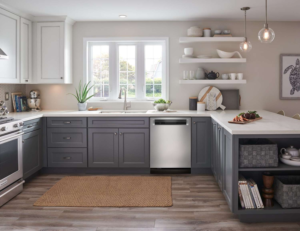A handyman is a professional who fixes various things around the house like a clogged sink or broken window. They usually charge hourly and can take care of multiple tasks in one visit.
Using a user-friendly site builder will allow you to create your handyman website without any coding knowledge. Make sure you include your insurance and licensing information on your site. Contact J&R Construction now!

While some homeowners consider themselves do-it-yourself (DIY) enthusiasts, there are times when a job requires more expertise than the typical homeowner possesses. A handyman can perform a range of repair jobs, including replacing bathroom or kitchen fixtures, fixing leaky faucets and installing new toilets. They can also refinish wood furniture and install flat-screen televisions on walls.
Compared to general contractors, handymen typically do less complicated projects and have fewer licensing requirements. Nevertheless, both focus on repairs and construction. However, a general contractor oversees a variety of large scale construction projects and is responsible for hiring subcontractors and ensuring that building projects comply with all local codes and zoning regulations.
In addition to repairing appliances, a handyman can replace lighting fixtures, ceiling fans and other decorative hardware. Replacing these items can refresh a room’s appearance and improve a home’s energy efficiency. In addition, a handyman can replace outdated cabinet hardware, such as handles and hinges.
When it comes to flooring, a handyman can lay tile, refinish wood floors and paint interior walls. They can also assemble and paint various types of furniture, including beds, bookcases and desks. Handymen can also handle a variety of other maintenance tasks, such as mowing lawns, trimming hedges and bushes and cleaning gutters.
Aside from the obvious benefits of being able to check off all those pesky tasks on your to-do list, hiring a reliable handyman service can save you time and money. Assuming that the task is not too complex, a handyman should be able to do it for a fraction of what it would cost to hire a professional. If the task is too extensive for a handyman to handle, they will usually refer you to a specialist that can meet your needs and budget.
Assemblies
Assemblies are compiled outputs that are used to package applications for easy deployment. They contain metadata, version information, and a manifest of all the assembly components. An assembly is the smallest versionable unit in the common language runtime; all types and resources in an assembly form a logical unit of functionality. Private assemblies reside in the application directory and are unique to the application that uses them; shared assemblies, such as those containing localization resources or utility classes, are stored in GAC.
The assembly also contains information on dependencies, such as other assemblies or external files. When an assembly is loaded, the CLR verifies that all dependencies are met. The verification process is accomplished by comparing the hash value of each file in the assembly with the hash value of the same set of files as they existed when the assembly was built. This is done only with strong-named assemblies, and the comparison takes place at runtime, before the assembly is injected into memory.
A handyman is a professional who is skilled in assembling furniture units like bookshelves and desks. They can follow instructions well and take the time to set up each piece properly so that it looks good. These professionals often hold liability insurance to give clients added peace of mind that their work is in safe hands.
Aside from furniture assembly, a handyman can also help with the refinishing of wood pieces and other tasks around the house. They can install shelving, repair cabinetry, and fix doors. They can even replace light fixtures and electrical outlets. Their services are affordable and convenient, making them an excellent choice for busy homeowners. Aside from their expertise, these professionals also offer a high level of customer service and care.
Painting
A fresh coat of paint can transform the look and feel of any room. A painting handyman can help with selecting colors and providing expert advice on application techniques. Their experience in surface preparation and painting will ensure a smooth, durable finish that protects surfaces from wear and tear.
Painting projects can be tricky and time-consuming, especially for larger spaces or intricate surfaces. Unless you have the right tools and experience, DIY painting can cost more than it’s worth. A handyman can save you the headache and expense of a disappointing DIY project with their expert skills and professional-quality equipment.
Whether you need to touch up a single wall or refresh the entire interior, a handyman can handle the job quickly and professionally. They can even work on exterior painting projects, such as repainting decks and sheds.
Paint can be a messy task, so a handyman will clean up after themselves and leave your home as they found it. They’ll take care to cover furniture and fixtures, and they can even apply protective coatings to prevent scuffing and chipping.
Aside from tackling painting jobs, a handyman can also install new doors and cabinet hardware. They can also hang heavy items like mirrors and artwork, or mount your TV so it’s safely anchored to the wall.
Unlike other trades, handymen don’t need any formal qualifications or licenses to perform their work. They typically rely on customer referrals and their own expertise to provide quality service. However, it’s important to find a reliable and reputable handyman who has the experience and skills needed for your project. This includes checking references and reading reviews to ensure you’re hiring someone who will do a good job.
Plumbing
Plumbing can be a tricky task. If you have a major issue that requires an extensive fix, such as a broken water heater or leaky pipes, you should hire a licensed plumber to do the job safely and correctly. A handyman is better suited to handle smaller, less complicated plumbing tasks that don’t require extensive expertise or equipment.
Minor plumbing issues, such as a dripping faucet or a toilet that won’t stop running, are a good example of a task that can be performed by a handyman. Also, a handyman can handle basic installation jobs for appliances that require a connection to the water system, such as a dishwasher or washer.
Most states have specific licensing requirements for plumbers and handymen. It’s important to check your state’s laws to see what these are. If you aren’t sure if a certain task is within the scope of your handyman’s license, contact your local licensing department and ask about what types of work they allow.
While many handymen are jacks-of-all-trades, some have areas of specialization. Choosing one with experience in a particular field, like plumbing, can ensure they are up-to-date on the latest techniques and tools.
It’s also worth noting that hiring a handyman to perform plumbing work could void any warranties on your home’s fixtures and appliances. This means you may end up paying for costly repairs that were not covered by the warranty if the repairs aren’t done by a licensed professional. Also, if you’re looking to save money on repairs, an inexperienced handyman may take longer to complete the job or may cause further damage to your plumbing system during the process. This can add up quickly and significantly.
Electrical
If you want to make sure that your electrical system is functioning properly, it’s important to have a professional handle any necessary repairs. Handymen often have the skills to fix a wide variety of home electrical problems, such as flickering lights and broken switches. They can also run wires through walls and install light fixtures and ceiling fans. However, when it comes to more complex issues like faulty wiring or dangerous voltage surges, homeowners should hire an electrician instead.
Many electrical issues can be dangerous and even deadly if not fixed in a timely fashion. For instance, if you have an older fuse box that can’t handle the amount of electricity that modern appliances use, it could cause overloading and arcing. This can lead to fires and other serious consequences. A handyman can upgrade your fuse box to a more modern one, which will give you more circuits and help prevent overheating.
Moreover, handymen can take care of routine maintenance tasks such as replacing smoke detectors and carbon monoxide detectors. They can also install and replace batteries in these devices. This is important for safety and compliance with regulations set by local governments or fire departments.
While it is true that some types of electrical work require specialized training and certification, most minor tasks can be handled by a skilled and experienced handyman. To avoid any mistakes or damages, it’s best to find a professional who has experience working with these kinds of projects and follows safety protocols. Homeowners can check their handyman’s qualifications for electrical work by asking for references and reading online reviews. They can also ask about their licenses and insurance to ensure that they’re qualified to handle the job in question.
